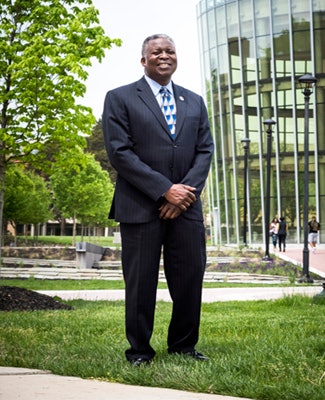As he exited his post this summer as president of Maryland’s Bowie State University, Dr. Mickey L. Burnim took a pause to reflect on his more than two decades at the helm of two state institutions — each for more than 10 years.
“It’s always been broad and far reaching,” says Burnim, describing the historical role of a college or university chief executive.
Today, the role is the same in many respects, he adds, yet it has also changed.
 Dr. Mickey L. Burnim says college presidents “are never really off duty.” (Photo courtesy of Bowie State University)
Dr. Mickey L. Burnim says college presidents “are never really off duty.” (Photo courtesy of Bowie State University)“External scrutiny has really increased significantly,” says Burnim, as have more aggressive challenges from an increasing number of directions. “The expectation for fundraising has intensified and increased dramatically,” he notes, saying that fundraising for public and private institutions has risen in priority from being one of many chores on a president’s to-do list.
Top institution officials must still play the role of chief administrator, visionary and ambassador, Burnim says, recalling that one of his last duties on the job was responding to a 6:45 a.m. call on a Saturday morning to console the family of a graduating student murdered hours earlier by an unknown assailant on another campus. The incident occurred just a few days before Bowie State’s graduation — Burnim’s final one — where the student was to graduate with honors.
“The president has to field that call to deal with parents and the media,” says Burnim. “You are never really off duty.”
Still, the “broad and far reaching” part of being an institutional leader is much broader and more far reaching, he says, in offering advice to future and aspiring presidents and chancellors. This assessment is based on years of personal experience. “Make sure your motives are service-oriented,” he tells those who want to be college presidents. “It’s more than a notion and requires great personal sacrifice.”
Institutional leaders of today and tomorrow must be prepared for the current demands of a college presidency, Burnim suggests, explaining that external scrutiny from state lawmakers coupled with handling tighter budgets and dealing with accrediting boards and governance and advisory panels have become “tremendous.”
Presidents need to be prepared to successfully deal with increasing calls from all of these stakeholders, he says.
College presidents are tasked with the challenge to raise more money. As he exited Bowie State University, he was also trying to raise $1.5 million to endow the institution’s first chair. The university wants and needs more to offset declining state spending and funds from other sources, he adds. In 2016, the university reported an endowment of $5.9 million to help sustain an institution of 5,600 students, most of whom are enrolled full-time.
There are some proven routes to reaching the point of being a successful and long-term chief executive, says Burnim, assuming that one plans to stay at least five years in a job.
“One should hone one’s skills for picking your team,” he suggests, referring to the importance of building the right executive leadership team.
“People don’t automatically come to a job thinking as a team,” says Burnim, explaining that as a president or a chancellor one can end up bringing bright people together who still end up doing a poor job because they are not organized to function as a team.
“You have to have a lot of people who have different skill sets,” Burnim advises. “You (a president or chancellor) need them working together.” He adds that it took him about five years in his first leadership post to hone his skills as a chief executive.
Burnim’s first chief executive job was as chancellor of Elizabeth City State University of North Carolina. He was there for 11 years. Then he went to Bowie State in 2006 where his term was scheduled to end on June 30, 2017.
Another key, he says, is working effectively and cooperatively with alumni, historically one of the more vocal yet smallest participatory and donor groups of most institutions.
“We have a lot of work to do in educating our alumni,” says Burnim, who is credited with maintaining a good rapport with his small alumni, estimated last year at around 300 active graduates, who are among the lowest level of donors to the state-controlled institution.
“I know how to be respectful, no matter how they are treating me,” he points out, adding that alumni and others with a vested interest in an institution will express a wide range of views, opinions, suggestions and attitudes. “I strive to be genuine, straightforward and show humility.”
As for the symbolic and real importance of being a president or chancellor, Burnim says that it’s important to understand that the job has no down time.
“You’re never off duty and people are always watching what you say and what you do,” he says, offering an example: “People take note of what school leaders wear, even when seen on a grocery shopping trip, and what they say, even in the most informal of situations.”
There are some personal codes of conduct current and aspiring leaders must exhibit, says Burnim, regardless of the contexts in which a president or chancellor may encounter his or her public.
“Be genuine,” he says. “Show integrity. Don’t try to mislead people. People appreciate integrity, consistency and candor,” he says, even when they differ with you.
- This story also appears in the June 29, 2017 print edition of Diverse.



















